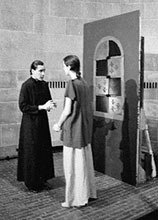

In a bizarre turn of events, Joan of Arc is making an unprecedented appearance in two different theater productions this weekend. Perhaps you've seen the chalkings on the sidewalks that read "Recant or Burn!" without any explanation. Well let the mystery end. It was not the product of religious fanatics, it was just PR for Joan at the Stake, a short play written by Maggie Robbins and Robert Maggio which is taking the pulpit at Fairchild Chapel under the direction of college first year Liz Harlan-Ferlo.
The purpose of the play is not to tell the tale of Joan of Arc. In fact the play assumes a basic knowledge about her life and begins near its end, when Joan has already been tried for witchcraft and heresy and is simply awaiting her fiery death sentence. It is an interesting period of focus for a treatise on Joan of Arc; almost a footnote in the context of her fascinating life story.

So one wonders what the main issue is in this play, if the subject is not really her heroic life nor her tragic death. The answer, it seems, lies in the play's other character, the Bishop of Beauvais, who was the main judge in her trial. The action centers around the interaction between Joan and the Bishop in her last days. It works to compare the two figures, holy man and heretic, and examine their different modes of spiritual calling under the same light.
The set design for the show sets up an environment that unites Joan with the Bishop. Joan's prison cell and Beauvais' chamber are symmetrically arranged on the stage, and both contain stained glass windows which although reflecting different colors, are made of the same materials and shape. It is the same way that Joan and Beauvais, although responding to different voices, are driven by the same blind faith.
The direction of the characters also reflects this similarity. Both Beauvais, played by college junior David Ellis, and Joan, played by college first year Elizabeth Koster, have monologues which involve communication with otherworldy spirits; Joan with St. Catherine and St. Margaret, and Beauvais with God. When engaged in these monologues, both actors look out, beyond the audience, beyond physical space, into the dark unknown. They are both wide eyed, hopeful, and desperate for answers.
Joan claims to have been hearing the voices of St. Catherine and St. Margaret all her life. They dictated her mission to lead French armies against the British and pave the way for the coronation of Charles VII, making her an unquestionable hero. And yet it was those voices that led to her trial as a (delusional) witch and her brutal death.
The bishop takes the role of the reformer, he urges her to recant; to answer to God and save her soul. And yet Beauvais finds it difficult to maintain his authority with Joan. He is humbled by her conviction. After all, he trusts in a voice that he can't hear; there's nothing that makes his belief more legitimate than hers. Beauvais even states at one point that he wished he could hear voices when he was a child.
Ellis is better at portraying the vulnerable side of the Bishop than the stern, authoritative side. It is difficult to buy into the power Beauvais has over Joan because the acting feels insincere at times. Ellis actually overplays the Bishop, so he ends up being loud but not commanding, and serious but not contemplative. One is very conscious of the fact that Ellis is playing a character instead of embodying the character.
Koster's portrayal of Joan is more convincing, partly due to the intensity of her fantastic facial expression. However, the character comes off as being too sweet and childlike. Her demeanor does not become a woman warrior who has survived the hell of the battlefield. She also jumps from fear and recantment to bravery and defiance without enough change in emotion. As a result, these decisions feel arbitrary and without motivation.
However there are two notable moments when showing the fragile side of Joan is warranted, and Koster plays these effectively. The first comes when Joan contemplates the cold loneliness of her virginal status and kneels and pleads for human contact. The other comes during her actual execution. Koster delivers the same chant like call to her beloved saints, but this time interrupts it with sudden losses of breath as the flame (here signified by a glowing candle) supposedly engulfs her.
As a venue, Fairchild Chapel seems like wonderful space to stage this show. Indeed, the mood is certainly enhanced by the evocative setting which is at once austere and gentle. However, the acoustics of the space are not ideal for the clear projection of the actors' voices. The words of the actors were often lost in the distracting echoes.
All in all, the play is a decent effort, especially for a college directorial debut. It is tough to give these characters depth and complexity in the short span of the play (a brisk 35 minutes). Still, the play does offer an interesting take on a woman who has been interpreted in hundreds of ways. It's amazing. Joan of Arc was burned at the stake almost 600 years ago, yet she still manages to be one of the most captivating historical figures.
Joan at the Stake plays at Fairchild Chapel tonight and Saturday Night at 10 p.m. Tickets are $2.
Holy counsel: As the Bishop of Beauvais, David Ellis pleads for the soul of Joan of Arc, played by Elizabeth Koster. (photo by John Matney)
Copyright © 1998, The Oberlin Review.
Volume 126, Number 21, April 17, 1998
Contact us with your comments and suggestions.